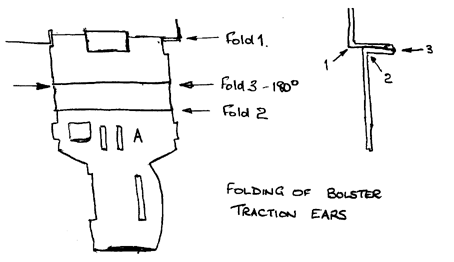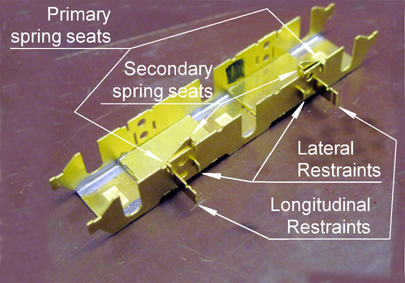 Remove the bolster centre etch from the fret, taking care not to distort the
'legs' of the etch.
Remove the bolster centre etch from the fret, taking care not to distort the
'legs' of the etch.These instructions describe the assembly of one of the two bogie bolsters.
 Remove the bolster centre etch from the fret, taking care not to distort the
'legs' of the etch.
Remove the bolster centre etch from the fret, taking care not to distort the
'legs' of the etch.
The hole in the centre of the bolster is sized to take a 10BA screw. To use the 2mm pivot screw supplied in the kit, open out the hole to 2.0mm. Make sure the hole is clean and thoroughly deburred.
Open out the holes using tapered broaches to ensure that centres are preserved. Deburr the holes using a larger drill.
 Make the two folds in the etch
Make the two folds in the etch
 Remove the two Upper Stiffener etches from the fret and fit them
into place. Clean up the faces of one of the 2mm brass nuts to remove any machine
oil and grease and prepare for soldering. Take one of the full-depth 2mm washers from the fret and
thread it on to one of the
2mm screws. Apply some grease to the washer and the top few threads of the screw. From the outside, pass
the screw through the central
hole in the top of the bolster frame and thread on the nut. Screw the nut into place between the
upper stiffeners and tighten up. Check that the nut is central between the stiffeners and flat
to the face of the bolster top.
Run generous fillets of solder around the nut and
the Upper Stiffeners.
Remove the two Upper Stiffener etches from the fret and fit them
into place. Clean up the faces of one of the 2mm brass nuts to remove any machine
oil and grease and prepare for soldering. Take one of the full-depth 2mm washers from the fret and
thread it on to one of the
2mm screws. Apply some grease to the washer and the top few threads of the screw. From the outside, pass
the screw through the central
hole in the top of the bolster frame and thread on the nut. Screw the nut into place between the
upper stiffeners and tighten up. Check that the nut is central between the stiffeners and flat
to the face of the bolster top.
Run generous fillets of solder around the nut and
the Upper Stiffeners.
Remove the screw from the nut (it should have been prevented from being soldered in place by the grease).
 Remove the two bolster side etches from the fret.
Remove the two bolster side etches from the fret.
 Fold up the traction ears as shown. Note that Fold 3 is 180° with the etched
slot on the outside of the fold. Make fold 1 first, then start fold 3. Finally, gripping surface A with
pliers and supporting the main part of the fret on a hard, flat surface, make fold 2 and complete fold 3.
Don't apply any solder to these folds just yet.
Fold up the traction ears as shown. Note that Fold 3 is 180° with the etched
slot on the outside of the fold. Make fold 1 first, then start fold 3. Finally, gripping surface A with
pliers and supporting the main part of the fret on a hard, flat surface, make fold 2 and complete fold 3.
Don't apply any solder to these folds just yet.
 Hold the bolster centre and bolster sides firmly together and tack solder them from the
outsides of the slots in the bolster sides. Keep solder clear of the places where the inner
and outer bolster frames will fit.
Hold the bolster centre and bolster sides firmly together and tack solder them from the
outsides of the slots in the bolster sides. Keep solder clear of the places where the inner
and outer bolster frames will fit.

 Remove two Inner Bolster Frame etches from the fret and ensure that any tags are
cleaned up from faces which mate with the inside face of the bolster sides. (The Inner Bolster Frames
are the ones which engage in the uppermost slots in the legs of the bolster centre). Fold them up,
fit and solder them
in place along the bolster sides, noting that each has a slot which engages in a tab on
the outside edge of the traction ears.
Remove two Inner Bolster Frame etches from the fret and ensure that any tags are
cleaned up from faces which mate with the inside face of the bolster sides. (The Inner Bolster Frames
are the ones which engage in the uppermost slots in the legs of the bolster centre). Fold them up,
fit and solder them
in place along the bolster sides, noting that each has a slot which engages in a tab on
the outside edge of the traction ears.
 For each traction ear, hold the two laminations of the traction ear firmly together and
clamp the end of the Inner Bolster Frame against its outside edge, engaging the tab and slot.
Ensuring that the other folds on the ear are at 90°, run a fillet of solder around
the underneath of the ear on the inside where it mates up with the end
of the Bolster Frame.
Ensure that the spring holes in the Inner Bolster Frames are free of solder.
For each traction ear, hold the two laminations of the traction ear firmly together and
clamp the end of the Inner Bolster Frame against its outside edge, engaging the tab and slot.
Ensuring that the other folds on the ear are at 90°, run a fillet of solder around
the underneath of the ear on the inside where it mates up with the end
of the Bolster Frame.
Ensure that the spring holes in the Inner Bolster Frames are free of solder.
 Similarly fit the two Outer Bolster Frames.
Similarly fit the two Outer Bolster Frames.
 Fold up and fit the Central Stiffeners / Spring seats. The spring seats fit between the
inner edges of the traction ears, engaging in similar slots to the Bolster Frames on the outside. You will
find, if you start by sliding the 'noses' of the spring seats between the opposing edges of the
traction ears, that the stiffeners can be sprung into place between the traction ears. Again holding
the 180° folds of each traction ear firmly together, run a good fillet of solder under the traction
ear where it engages with the Central Stiffener.
Fold up and fit the Central Stiffeners / Spring seats. The spring seats fit between the
inner edges of the traction ears, engaging in similar slots to the Bolster Frames on the outside. You will
find, if you start by sliding the 'noses' of the spring seats between the opposing edges of the
traction ears, that the stiffeners can be sprung into place between the traction ears. Again holding
the 180° folds of each traction ear firmly together, run a good fillet of solder under the traction
ear where it engages with the Central Stiffener.

Pair up the bolster with its subframe, as designated by the presence or absence of the tiny etched triangular marks. Note that the outer end of the bolster, as distinguished by the horizontal parts of the outer bolster frame being lower than those of the inner bolster frame, should be oriented towards the coupling end of the subframe.
 Check the bolster for dimensions and squareness:
Check the bolster for dimensions and squareness:
A tight fit can be addressed in the first instance by light filing on the circular edges of the traction ears or lateral restraints to remove etching cusps. Other adjustments may be made by gentle tweaking of either the bolster assembly or the longitudinal restraints. If you do need to tweak the bolster, try to end up with the faces of the traction ears vertical; adjust the fit over the lateral ears by grasping firmly the central arch as well as by rotating the outriggers.
Clean up the bolster assembly to remove all flux residues. If you wish to chemically blacken the bolsters and subframes, do it at this stage.